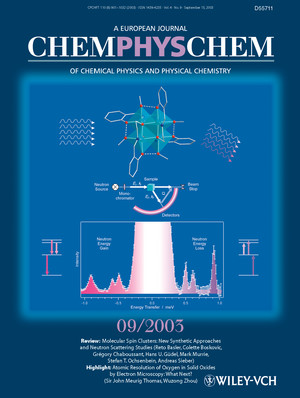Abstract of Publication No. 461
 Reto Basler, Colette Boskovic, Grégory Chaboussant, Hans U. Güdel, Mark Murrie, Stefan T. Ochsenbein and Andreas Sieber
Reto Basler, Colette Boskovic, Grégory Chaboussant, Hans U. Güdel, Mark Murrie, Stefan T. Ochsenbein and Andreas Sieber
Molecular Spin Clusters: New Synthetic Approaches and Neutron Scattering Studies
Chem. Phys. Chem. 4, 910-926 (2003)
![]()
![]()
![]()
![]()
![]()
Abstract:
We review our recent work in the field of molecular spin clusters and
single-molecule magnets, showing how inelastic neutron scattering (INS) can be
used to determine magnetic exchange interactions and anisotropy splittings. A
general introduction to neutron scattering precedes selected examples, building
upon the first determination of exchange coupling in a transition metal complex
using INS, through anisotropic exchange in cobalt(II) spin
clusters to the determination of exchange interactions in a dodecanuclear
nickel(II) wheel. The strength of INS for the accurate
determination of anisotropy splittings in single-molecule magnets is revealed.
Not only can one determine the axial zero-field splitting parameter D,
which plays a key role in single-molecule magnet behavior, but also higher-order
terms important in understanding the quantum tunneling behavior. Finally, we
review two of our synthetic approaches towards new single-molecule magnets based
on nickel, manganese, and iron.
Cover Picture:
The cover picture shows the principles of inelastic neutron scattering
(INS) in magnetic molecular clusters. An incoming monochromatic neutron beam is
scattered by a target sample (here a tetranuclear nickel(II) complex) both elastically (no energy
transfer) and inelastically (positive or negative energy transfer). Scattered
neutrons of varying velocity are then collected in detector banks that span a
wide angular range. The interactions between the magnetic moments of the sample
and the neutrons that occur during INS allow the investigation of the magnetic
properties of the material and the accurate determination of the relevant
parameters, including those associated with exchange interactions and
magnetoanisotropy. This is nicely illustrated by the inelastic peaks, observed
on both sides of the elastic line, which correspond to magnetic energy transfer
between the neutrons and the sample. INS is a unique technique that affords a
detailed insight into the magnetic levels over a large energy range (up to 1000
cm–1) and thus can provide crucial information for a wide variety of
magnetic materials.